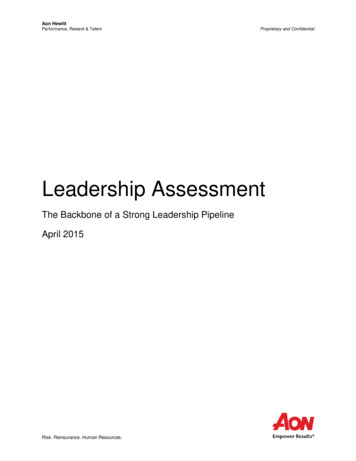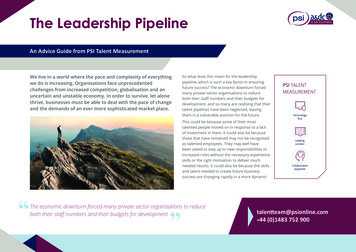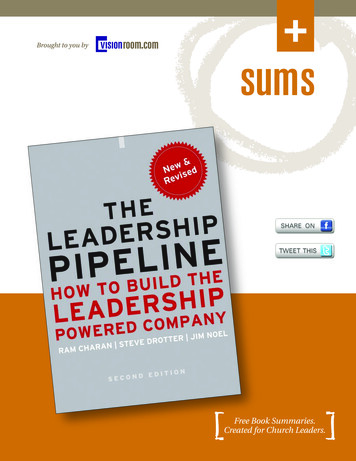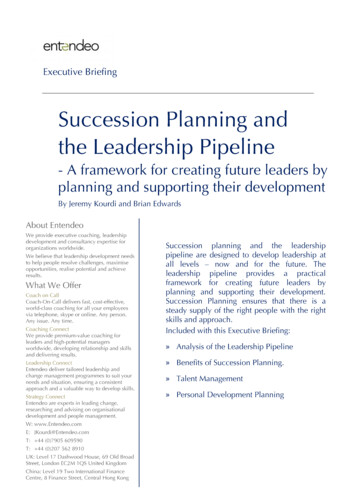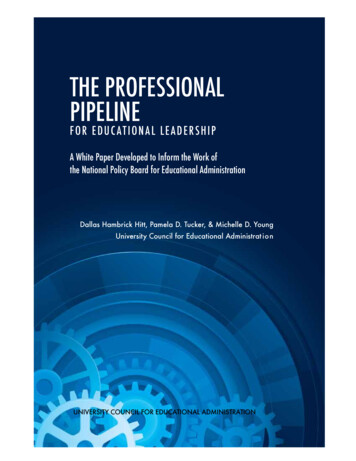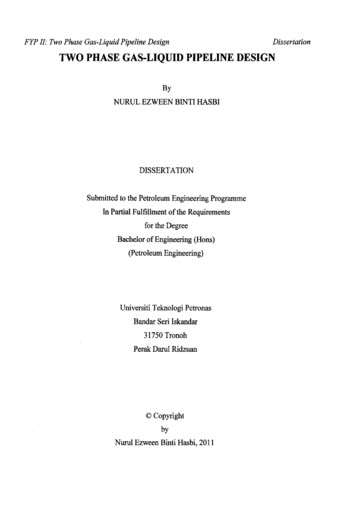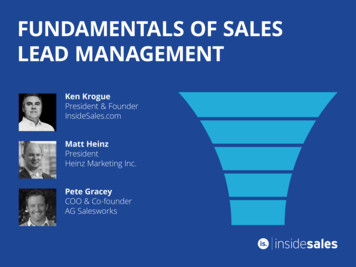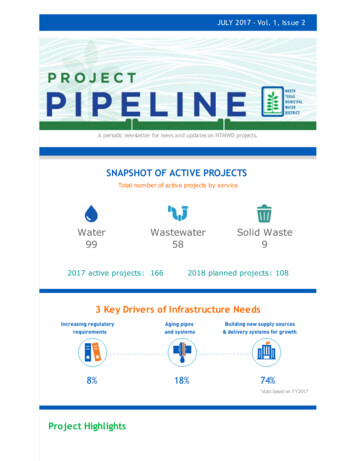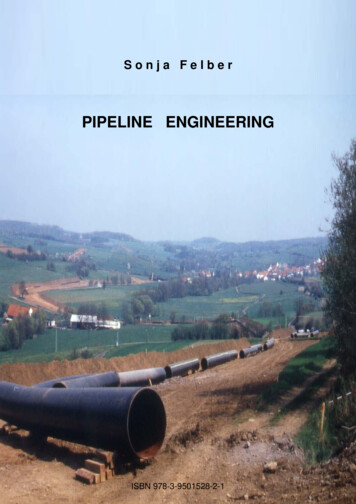
Transcription
White PaperBuilding a Leadership PipelineBuilding aLeadership Pipeline“Companies are successful to theextent that they have leadersat all levels of the organization.Any institution that invests inthe development of leaders at alllevels is going to get ahead of itscompetition”Ferguson enjoyed a 26 year tenure as manager ofManchester United, during which time he successfullyguided the club towards 38 domestic and internationaltrophies and augmented Manchester United’s financialposition as the second richest sports team in the worldwith a value of 3.165 billion (Forbes). In a recent HarvardBusiness Review article, Ferguson reflects on the stateof the team, and the entire club, upon his arrival toManchester and how he predicted that future successwould be entirely dependent on how they developedemerging talent at the club.– Noel Tichy, Director of the Global LeadershipProgram at the University of Michigan BusinessSchoolIntroduction“From the moment I got toManchester United, I thought ofonly one thing: building a footballclub. I wanted to build right from thebottom. That was in order to createfluency and a continuity of supplyto the first team When I arrived,only one player on the first teamwas under 24. Can you imagine that,for a club like Manchester United? Iknew that a focus on youth wouldfit the club’s history Building a clubbrings stability and consistency. Youdon’t ever want to take your eyesoff the first team, but our youthdevelopment efforts ended upleading to our many successes in theA leadership pipeline strengthens the leadership functionof a company by cultivating emerging talent whileenhancing organisational capability (Dilworth et al. 2011).Developing a leadership pipeline starts with identifyingand then nurturing talent by exposing high-potentialindividuals to a variety of developmental opportunitiesand experiences. This leads to a more wide-ranging andholistic knowledge of the business and its inner workings.Put simply, this process is done to ensure that importantleadership positions in the most prominent functions canbe filled very easily by internal candidates. In this whitepaper, we explore the factors to consider when buildinga successful leadership pipeline.What goes into a leadership pipeline?It is best when leaders are grown, not imported, and theleadership function as a whole will never grow stronger anddeeper if an organisation only invests in replacement asopposed to development (Charan, Drotter & Noel, 2001). Soa leadership pipeline should combine succession planningwith leadership development well before a replacement isneeded. One of the best examples of integrating successionplanning and development of emerging leaders is that ofSir Alex Ferguson.1 The Insights Group Ltd, 2014. All rights reserved.
White PaperBuilding a Leadership Pipeline1990s and early 2000s. The youngplayers really became the spirit ofthe club If you give young peopleyour attention and an opportunityto succeed, it is amazing how muchthey will surprise you”This changing demographic poses a very significantchallenge for all organisations. Roughly one in five seniorexecutives from Fortune 500 companies are eligible forretirement right now and in the US alone it is estimatedthat 30 percent of the population will be over the age of55 by 2020 (Yost & Plunkett, 2009).This means that the leaders of tomorrow within anorganisation may be leaving due to the short sightednessof their employers. They are not being affordedappropriate developmental opportunities and areessentially being stifled in terms of the empowermentand accountability that they seek. As their moreexperienced colleagues remain in leadership positions forlonger, these younger potential leaders are not able togain the valuable managerial experience that could helpprogress their careers. This can result in potential futureleaders being acquired by competitors who are willing togive them such opportunities.– Ferguson’s Formula, October 2013The combination of succession planning and leadershipis of course just one aspect of a successful leadershippipeline, albeit a very important aspect. But withthe ever-increasing requirement to develop a stronginternal ‘leadership bench’, what are the steps you asan organisation should be taking to ensure you aremaximising the future strength of your leadershipfunction?What’s blocking leadership pipelines?Leadership development is a fairly simple concept at itscore: the younger employees within an organisation willdevelop, be exposed to different environments on theirway up through the professional ladder and eventuallybecome the leaders of tomorrow.The strong young leaders, millennials born between1980 and 1995, emerging today often bring with thema different style of leadership that relies on heightenedsocial needs and a stronger team orientation thanprevious generations (Borges, Manuel, Elam, and Jones,2010). Being a part of the generation they are nowleading means they have a greater understanding ofhow their staff prefer to communicate and they knowthat this generation, more than previous ones, tends toseek frequent, positive, and open communication in theworkplace (e.g., Gursoy, Maier, & Chi, 2008).Are leaders born or made?Many organisations tend to assume that people simplyeither have leadership potential or they don’t. In a reviewof the current leadership literature which consideredcompeting leadership theories and models, Yukl (2006)concluded that there are ‘serious weaknesses in much ofthe behavioural research conducted during the past twodecades,’ noting ‘a tendency to look for simple answersto complex questions’ (p. 75). What Yukl actually foundwas that there was no blueprint for successful leadership,but there appeared to be a pattern of behaviour whichreflected a high concern for both task- and relationshiprelated criteria.However, Zenger (2013) asserts that the global recessionof 2008 to 2012 has led to two major outcomes whichare impacting the potential success of the leadershippipeline: one being that senior executives are stayingin their positions longer in order to gain more financialsecurity; the other blocker being that organisationsare experiencing a reduction in hiring due to budgetconstraints. Both of these outcomes have led to a lackof millennial leadership opportunities and as such, havesomewhat diminished the opportunities of internal hiringthat an effective pipeline brings.The best leaders always seemed to get the right balanceappropriate for the specific situations they were in, andfound it was a capability that got better with experience.Leaders can progress upwards in their own function,move laterally to another function or another role, andeven take a few backward steps in getting where they2 The Insights Group Ltd, 2014. All rights reserved.
White PaperBuilding a Leadership Pipelineand ensures development is a constant rather than acommodity that is only acted upon after performancereviews, or quickly forgotten. Groves (2007) writesabout several industry examples where this internaldevelopment has been made common practice, withresounding success.want to be (with failures and mistakes consistentlybeing ranked as one of the critical experiences in thedevelopment of leaders). Thus, judging leadershippotential too early and on fairly unsubstantiatedassumptions should be avoided wherever possible. Yost& Plunkett (2009) assert that the best leaders ultimatelydevelop in the continuous stretch, tumble, and bump ofthe real world, and need to be afforded the opportunitiesto do so.“There is also growing evidencethat organizations are increasinglyengaging managerial personnelin the leadership developmentprocess, and that managers addunique value to building theleadership pipeline beyond thatof management developmentspecialists, consultants, academics,or other professionals (Tichy, 2004;Allio, 2003). The most prominentexample of this approach isGeneral Electric’s (GE) John F. WelchLeadership Center at Crotonville,a comprehensive developmentprogram in which executives andmanagers at all levels are largelyresponsible for teaching thecurriculum and delivering a range ofleadership development activities(Tichy, 1989) Not surprisingly, manyCEOs at leading companies haveadopted the executive-led approachto leadership development,including 3M’s Jim McNerny,Yum!Brands’ David Novak, HomeDepot’s Bob Nardelli, and Nokia’sJorma Ollila”Components of a good leadershippipelineThe first thing a leadership pipeline should be is simpleand transparent. If the path towards senior leadershipappears ambiguous or if the scope appears too broad, itwill likely fail (Zenger, 2013). Managers will be significantlymore engaged when they know exactly where they standon the leadership ladder, and what they need to addressin order to progress. Many companies have taken stepsto ensure this kind of information is readily available.For example, at the global pharmaceutical company EliLilly, managers can track a battery of metrics that give animmediate measure of the readiness certain employeeshave to fill its top 500 positions. At Dow, they measurethe success of their leadership development program bylooking at the number of internal hires that fill prominentpositions within the organisation. They consider it asuccess when this number runs between 75-80%, witha parallel train of thought being that at least some newblood needs to be brought into to maintain a streamof new ideas, innovation, new methods of working andto fill any unanticipated positions that may occur in thefuture (Conger & Fulmer, 2003). This allows the businessto build up a bank of talent where it is needed most andwhen the time comes to fill these positions, they canbe filled sequentially by internal candidates who havegained the necessary experience and capability to hit theground running. Typical metrics associated with assessingcurrent strength of organisational talent are recruitmentand staffing metrics (time taken to fill key positions),performance management metrics (goals, developmentplans, performance, etc.) and staff turnover metrics(employee engagement, attrition, etc.).There also needs to be a strong focus on developmentwithin the organisation, otherwise, where will the talentcome from to fill positions internally? A common methodadopted in the past decade is to get current managersimmersed into developing the people in their ownteams, empowering them to become better coaches.By empowering managers to develop potential leaders,constructive feedback is delivered on a regular basis3 The Insights Group Ltd, 2014. All rights reserved.
White PaperBuilding a Leadership PipelineThe focus on development also needs to be targeted onthe skills that the organisation knows it will need in thefuture. In order to do this effectively, potential leadersmust go through a blended approach to their learning.This might consist of a mixture of web-based andclassroom based learning, ideally having access to onlineand offline support as and when needed and perhapsmost importantly, ‘on the job’ learning where potentialleaders are exposed to different areas of the business.Again, this experiential based development should notbe arbitrary and tying this into overall business strategyis a very good way of keeping the experiences relevant.It also provides the context for what is consideredimportant and unique to that particular organisation.Typical experiences which organisations have foundbeneficial for emerging leaders include: experience offirst supervisory position, managing a project of largerscope, key business unit experience, secondments todifferent regions and many others.3.Create a learning culture. Constantly ask the difficultquestions of your organisation that enables growthand the development of new skills4.Create a feedback-rich environment. Ensureconstructive conversations that speak to currentstrengths and weaknesses, but also to one’s potential5.Focus on transitions. Create opportunities fortransition within your business, and that these areset up for success as opposed to letting peoplemerely sink or swim6.Build a principle-based organisation. Reinforceleadership as the living embodiment of yourcompany values, at all levels of the organisation7.Remember to focus on significance. Focus on theoutcomes that will make the process sustainableBenefits of a leadership pipelineapproachOrganisations are increasingly finding a lack of capableleaders at executive, functional and general managementlevels. This trend is predicted only to get worse; McKinseyGlobal Institute (2012) forecasts that employers inadvanced economies will have a shortage of 16 to 18million workers in skilled positions requiring tertiaryeducation compared to what will be available in theexternal labour market.To contend with this reality, Byham, Smith, & Paese (2002)outline the three options available to organisations:There are many other components of an effectiveleadership pipeline that could be identified in thispaper. Just as Northouse (2004) concluded that ‘thereare almost as many different definitions of leadership asthere are people who have tried to define it’ (p. 2), thereare probably as many successful individual componentsof a leadership pipeline as there are companies tryingto achieve one. However, in the interest of conciseness,there are not too many better examples that Yost &Plunkett’s (2009) 7 point plan:1.Start with the business strategy. Leverage thebusiness strategy by identifying developmentalexperiences that are critical to achieving it2.Build a rigorous performance management systemand use it. Separate performance and developmental,but ensure a heavy focus on both41.Intensify efforts to hire hard-to-find, increasinglyexpensive people from outside their organisation;2.Do nothing and likely experience a competitivedecline, which could lead to being acquired orgoing out of business; or3.Tap into the quality people already in theirorganisation, thus growing and keeping theirown leaders The Insights Group Ltd, 2014. All rights reserved.
White PaperBuilding a Leadership PipelineConclusion“What could be more crucial toyour organization’s performancethan the choice and cultivation ofits future leaders? Why, then, dotraditional succession plans sooften fail? Because great leadershipat the top of your organizationactually begins in the middle”– Conger & Fulmer, 2003By building a successful leadership pipeline that ensuresstrength and depth in lynchpin functions, organisationsare effectively exercising the third option and growingtheir own leaders. This is a major benefit in itselfbut it encourages several by-products that are alsoadvantageous, these benefits include: A significant reduction of resources requiredto attract outside talent Retention of the organisation’s best talent as theyare engaged by the different opportunities becomingavailable to them and so do not need to seek theseopportunities within competitors or alternateindustries Opportunity for personal growth through valuableon the job experiences for emerging talent. Thisbenefits not only the individuals as they find outmore about how they learn best so that this can bereplicated, but the organisation benefits as theseexperiences are being tailored toward importantaspects of its future successDespite all the informed perspectives within thispaper, the success of a leadership pipeline can be fairlycrudely boiled down to two pertinent criteria: beingable to identify what the key leadership roles in yourorganisation will be going forward and the numberof internal candidates who are capable of assumingthose roles when needed. It sounds easy when boileddown to this simple concept, but the extent to which anorganisation is successful depends on several factors thatwe have explored throughout this paper – both in termsof talent management and how that lends itself to futureorganisational capacity.This combination of building strength and depth inthe functions and positions that are pivotal to thefuture success of the organisation is where the effectiveintegration of succession planning and leadershipdevelopment is so important.5 The Insights Group Ltd, 2014. All rights reserved.
White PaperBuilding a Leadership PipelineReferencesYost, P. R., & Plunkett, M. M. (2009b). Real Time LeadershipDevelopment. New York, Wiley-Blackwell.Allio, R. (2003), “Interview: Noel M. Tichy explains why thevirtuous teaching cycle is integral to effective leadership”,Strategy & Leadership, Vol. 31 No. 5, pp. 20-6.Yukl, G. (2006). Leadership in Organizations, 6th ed. UpperSaddle River, NJ, Prentice-Hall.Zenger, J. (2013). Developing a LeadershipPipeline that Works. developing-a-leadership-pipelinethat-works/Borges, N. J., Manuel, R. S., Elam, C. L., & Jones, B. J.(2010). Differences in motives between Millennial andGeneration X medical students. Medical Education, 44,570-576.Byham, W. C., Smith, A. B., & Paese, M. J. (2002). Growyour own leaders: How to identify, develop, and retainleadership talent. Upper Saddle River, NJ: DevelopmentDimensions International Inc. & Prentice-Hall.Charan, R., Drotter, S., Noel, J. (2001). The LeadershipPipeline. San Francisco, Jossey-Bass.Conger, J. and Fulmer, R. (2003). “Developing yourleadership pipeline”, Harvard Business Review, Vol. 81 No.12, pp. 76-90.Elberse, A., & Ferguson, A. (2013). Ferguson’s Formula.Harvard Business Review, 91(10).Groves, K. S. (2007). Journal of ManagementDevelopment, Vol. 26 No. 3. pp. 239-260.Gursoy, D., Maier, T. A., & Chi, C. G. (2008). Generationaldifferences: An examination of work values andgenerational gaps in the hospitality workforce.International Journal of Hospitality Management, 27, 458488.Martin, J., & Schmidt, C. (2010). How to keep your toptalent. Harvard Business Review, 88(5), 54–61.McKinsey & The Conference Board (2012). The State ofHuman Capital.Northouse, P. (2004). Leadership: Theory and practice (3rded.). Thousand Oaks, CA: SageTichy, N. (1989). GE’s Crotonville: a staging groundfor corporate revolution. Academy of ManagementExecutive, Vol. 3 No. 2, p. 99.Tichy, N. (2004). The Cycle of Leadership: How GreatLeaders Teach their Companies to Win. Harper Business,New York, NY.Yost, P. R., & Plunkett, M. M. (2009a). Developingleadership talent through experiences. In R. Silzer, & B.Dowell (eds.), Strategy driven talent management: Aleadership imperative. San Francisco, CA: Jossey-Bass.6 The Insights Group Ltd, 2014. All rights reserved.
A leadership pipeline strengthens the leadership function of a company by cultivating emerging talent while enhancing organisational capability (Dilworth et al. 2011). Developing a leadership pipeline starts with identifying and then nurturing talent by exposing high-potentialFile Size: 1MB
